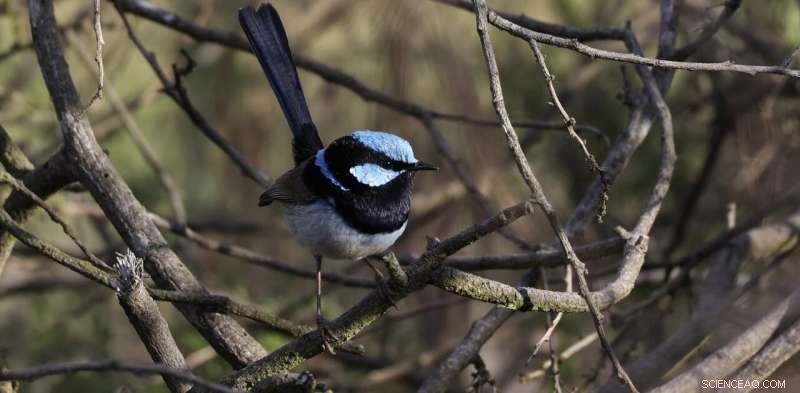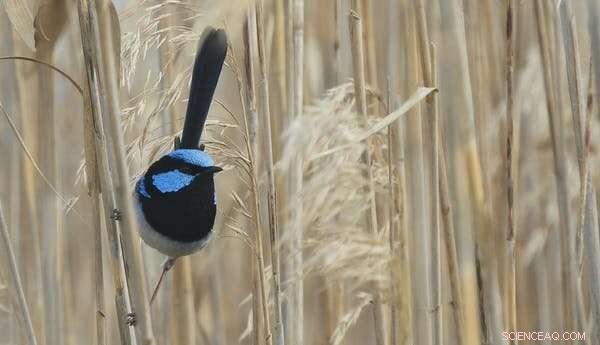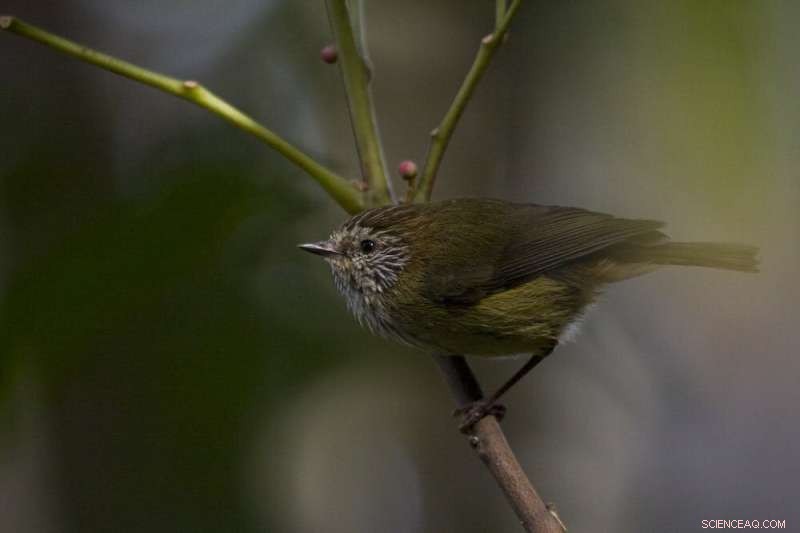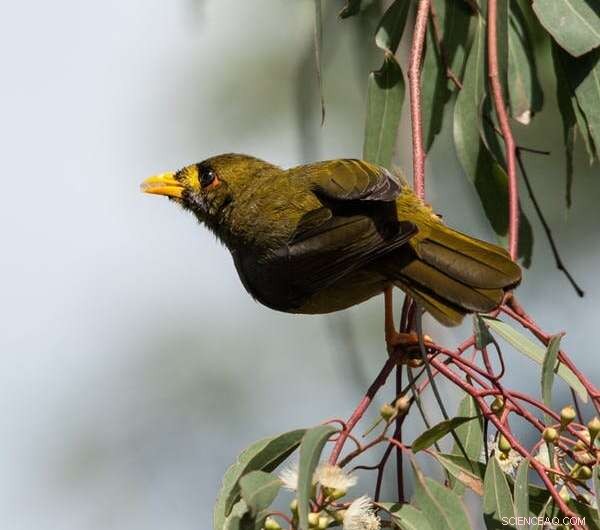
Crédit :Kaspar Delhey, auteur fourni
Un mystère que de nombreux biologistes veulent résoudre est la façon dont la complexité se développe dans la nature. Et parmi les nombreux systèmes sociaux du monde naturel, les sociétés à plusieurs niveaux se distinguent par leur complexité. Les individus s'organisent d'abord en familles, qui sont membres de bandes, elles-mêmes organisées en clans.
A chaque niveau, les associations entre composantes (individus, familles et clans) sont structurées et stables. En d'autres termes, les individus au sein des familles restent généralement ensemble, et les familles interagissent généralement avec d'autres familles spécifiques de manière prévisible, pour former des clans stables.
Une telle organisation sociale a probablement caractérisé une grande partie de l'évolution humaine (et est encore courante dans de nombreuses sociétés de chasseurs-cueilleurs à travers le monde).
En fait, les sociétés à plusieurs niveaux ont probablement joué un rôle fondamental dans l'histoire humaine, en accélérant notre évolution culturelle. S'organiser en groupes sociaux distincts aurait réduit la transmission des cultures et permis la coexistence de multiples traditions.
Dans notre recherche, publiée aujourd'hui dans Ecology Letters, nous avons étudié les comportements sociaux d'une population sauvage de superbes mérions. Nous avons découvert que ces oiseaux s'organisaient également en sociétés à plusieurs niveaux, un niveau de complexité autrefois considéré comme exclusif aux mammifères à gros cerveau.
Oiseaux reproducteurs coopératifs
Bien que nous ayons des idées sur les avantages des sociétés à plusieurs niveaux, nous savons relativement peu de choses sur comment et pourquoi elles se forment en premier lieu.

Les superbes féeriques mâles se distinguent par leur plumage nuptial bleu brillant.
Parmi les quelques espèces connues pour vivre dans des sociétés à plusieurs niveaux, il existe une caractéristique commune à toutes. Autrement dit, ils vivent en groupes stables, dans des environnements où la disponibilité de la nourriture est irrégulière et difficile à prévoir.
Cela est également vrai pour de nombreux oiseaux qui se reproduisent en coopération, y compris le superbe troglodyte féerique, familier dans les parcs et jardins du sud-est de l'Australie. Ils se reproduisent en petits groupes familiaux, avec des aides non reproducteurs qui assistent un couple reproducteur dominant. Et ce système social est courant chez les espèces d'oiseaux australiennes.
The superb fairy-wren is a well-studied species and is beloved by Australians, even being crowned bird of the year in this year's Guardian/BirdLife Australia poll.
These birds are notorious for their polyamorous approach to sex, despite being socially monogamous. Breeding pairs form exclusive social bonds, yet each partner will still mate with other individuals.
Our work now reveals this complex arrangement during the breeding season is just the tip of the iceberg.
Associating by choice
We tracked almost 200 birds over two years, by attaching different-colored leg bands to each individual. We recorded the birds' social associations and, from our observations, built a complex social network that let us determine the strength of each relationship.

Striated thornbills form larger flocks outside of breeding season. Credit:Kaspar Delhey
We found that during the autumn and winter months, some breeding groups – (which include the breeding pair, one or more helpers and last summer's offspring), stably associated with other breeding groups to form supergroups. And this was usually done with individuals they were genetically related with.
In turn, these supergroups associated with other supergroups and breeding groups on a daily basis, forming large communities. In the following spring, these communities split back into the original breeding groups inhabiting well-defined territories—only to join again next winter.
Just like humans, these little birds don't associate with each other randomly during the long winter months. They have specific individuals and/or groups they choose to be with (but we're currently not sure how they make this choice).
While it's not yet clear why superb fairy-wrens form upper social units (supergroups and communities), we suspect this might allow individuals to exploit larger areas during winter, when food is scarce. It would also provide additional safety against predators, such as hawks and kookaburras.
This theory is supported by our literature study, which shows that multilevel societies are likely common among other Australian cooperatively breeding birds, such as the noisy and bell miners and striated thornbills.
Cooperative breeding is another strategy to deal with harsh condition such as food scarcity. So the conditions that favor cooperative breeding are the same as those that favor multilevel societies.

The bell miner is endemic to south-eastern Australia. Credit:Kaspar Delhey
Multilevel societies in other animals
There are several other species which seem to have a similar social organization. They include primates such as baboons, and other large mammals that exhibit rich animal cultures, such as killer whales, sperm whales and elephants.
For a long time, researchers thought living in complex societies might be how humans evolved large brains. They also thought this characteristic may be exclusive to mammals with large brains, since keeping track of many different social relationships is not easy (or so the reasoning went).
Consequently, other animals with whom we are less closely related have mostly been excluded from this field of investigation.
This might reflect a bias that we, humans, have towards our own species and species which are similar to us.
As it turns, you don't need to be a mammal with a big brain to evolve complex multilevel societies. Even small-brained birds such as the tiny superb fairy-wren can do this—as well as the vulturine guineafowl a chicken-like bird from northeast Africa.
We strongly suspect quite a few birds will join their ranks in the coming years as more research is done.